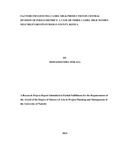| dc.description.abstract | This study was conducted in Central Division of Isiolo District in Isiolo County, Kenya.
The objectives of the study were to determine how camel feeds influence camel milk
production, to establish how camel milk marketing and infrastructure influence camel milk
production, to establish how camel breeds influence camel milk production and to assess
how extension services influence camel milk production in Central Division of Isiolo
District. The study was undertaken in the three purposively selected Camel milk Self help
Groups and these were Anolei Camel Milk Cooperative Society, Tawakal Women Self
Help Group and Defe Camel Milk Self Help Group. The target population of the study was
140 members of the women camel milk self help groups. Census method was used to
collect primary data from the three camel milk self help groups. Census sampling
technique was used for the study and all the 140 members of the three camel milk groups
were sampled for the study. The study was limited to Central Division of Isiolo District
and to the three camel milk groups. The study adopted a descriptive survey design and data
was collected using structured and semi-structured questionnaires. The data was also
collected from the three women groups by focus group discussions and personal
interviews. The results of the study show that majority of the camel milk producers used
full grazing and browsing as their main grazing system. The most common feed for
feeding camels were native browses (Trees and shrubs). It was also revealed that most of
the farmers don’t grow fodder because of insufficient information and insufficient rains.
For few who grow fodder, the mostly grown fodder forage was grass. The main feed
supplement bought was found to be mineral supplements like mineral licks. These feed
supplements are bought most of the time for the lactating camels. It was also revealed that
the feed supplements were bought from private agro veterinary retailers in Isiolo. The
study revealed that the main source of water for camels was the nearby river and wells
were used sparingly. It was also found that the farmers brought camels to the rivers and
water scarcity was found to be the main water related problem in the area. It was found that
farmers kept mostly single humped camels for milk production because they produce
higher volumes of milk. It was also shown that farmers used natural mating breeding
technique because they have no access to artificial insemination. The findings also show
there is also high demand for camel milk by consumers and there is lack of cooling
facilities in the area. The findings also show that the common causes of camel losses were
diseases, drought and camel rustling. The farmers also use herbal remedies because
veterinary services were not readily accessible and were expensive. The generated data
from the study will be useful to the camel farmers, Government officers and other stake
holders. | en_US |

